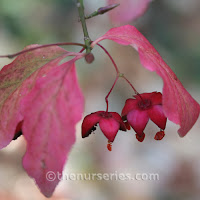It is now the bare root hedging season, when it is much cheaper to plant a hedge and a good time for establishment. Our winter stock has arrived and can be sent out mail order or can be chosen and collected from the nurseries.
Without doubt there are huge benefits in having a hedge for a boundary rather than a fence or a wall. Hedging plants are available here at the nurseries. We have evergreen hedging in pots all year round but from November to April we provide bare root hedging.
Our hedging is also dispatched around the country through our Mail order service and Ebay Store. Call 01280848038 to order.
Hedges act as wind and sound breaks, filtering us from noise, sheltering the garden from winds, Hedges support many species of wild life and they are economical as their durability to the elements and life span exceeds fences and walls. Hedges can also be beautiful, reflecting the seasons and providing a canvas to enhance other plants
How to choose the right hedge for your garden.
- Do you want the hedge to be purely ornamental
- All one variety or mixture of species.
- Formal or informal
- Dwarf or Tall
- Evergreen or deciduous
- Edible fruits
- Colourful
- Is it to be a strong boundary to hold live stock at bay.
- Is the site exposed? Consider the growing conditions
The choice of suitable hedge species is vast and the appearance equally varied. Below are some suggestion of popular native varieties :Many are available to buy as bare root stems from November to late Spring. Evergreen pot grown and root ball plants can bought and planted all year round. We stock laurel and privet and similar evergreens throughout.
Crataegus Hawthorn (Hedge Thorn, Quick Thorn, May Tree)
This is the most common form of hedge in the UK. It grows quickly. Its tough and very good on chalk. It produces blossom and later red berries(Haws). The prickles make it a strong barrier. This is deciduous hedge that mixes well with other species. It is excellent for wildlife.
Prunus spinosea (Blackthorn)
It is slower growing than Hawthorn but it benefits from being extremely strong and impenetrable. The stems traditionally make perfect walking sticks. A deciduous thorny plant, related to the plum. Black sloes are excellent for making Gin.
Corylus avellana (Hazel)
This is deciduous. It grows very dense. Strong flexible stems make it idea wood for building hurdles. It is noted for lovely catkins and cobs(hazel nuts)
Fagus sylvatica (Common Beach)
A golden brown hedge. Easy to maintain as a formal boundary with regular clipping. The leaves persist quite well through the autumn and into the winter. Slow to establish and does not establish well in wet heavy ground but it is great in all other situations and it tolerates alkaline soils and is fully hardy throughout the UK. It certainly makes one of the best hedges around. Equally good we have copper beach or purple beech a cultivar of common beech.The colour is fabulous.
Carpinus Hornbeam
This is also related to beech.It can create a good robust screen. Ideal where a fairly wide hedge is required. It copes well in clay or chalk soils. Autumn leaves usually remain attached until spring so it still provides a barrier or winter screening . Catkins appear in late spring followed by clusters of winged nutlets. Its great for avenues when grown large. One of the very best hedging choices similar to beech but retaining cover longer.

Acer Campestre (Maple)

Hardy strong in difficult clay soils and attractive as its in the maple family. The wood is has tough ribbed bark often used for carving. The foliage is a rich golden colour in the Autumn. Small yellowy green flowers open with the leaves in late spring later producing winged fruits we call helicopters! It grows well in limestone areas.
Viburnum opulus sterile (Guelda Rose)

Euonymus europa (Spindle)
A quick growing deciduous variety. White flowers are produced in summer. This has very attractive Autumn foliage and rather dainty unusual red pink fruits with orange seeds. It will thrive in most soils.
Rosa canina (Dog Rose)

Cornus (Dog wood)

Cornus hedging
A deciduous shrub that has very attractive red, yellow or lime green stems to admire in winter. Leaves can be green, silver and variegated some turning red in Autumn..
A Saxon Hedge
In recent year we have seen a revival in the original Saxon hedge. This is a mixture of native plants which in the right blend provide a good balance between a strong boundary and an attractive wild life habitat. Ideally it should contain 50% Hawthorn,20% Blackthorn,10% Field Maple, 5 % Hazel, 5% Dog Rose (Rosa Canina) 5% Viburnum Opulus (Guelda Rose) and 5% Spindle( Euonymus europa) Recommended planting instructions 4 plants per meter (3.25ft), in a double row at staggered spacing of 45cm apart (1.5ft) This rule applies to most bare rooted hedging. Encourage root growth and establishment by planting with fish blood and bone meal and where the structure needs improving enhance it with soil conditioner.







